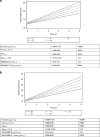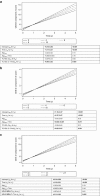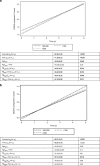Total serum cholesterol, atherogenic indices and their longitudinal association with depressive symptoms among US adults
- PMID: 25734511
- PMCID: PMC4354360
- DOI: 10.1038/tp.2015.4
Total serum cholesterol, atherogenic indices and their longitudinal association with depressive symptoms among US adults
Abstract
Serum cholesterol, both total and lipoprotein fractions, has been associated with mid- and late-life depression. Using longitudinal data on a large and ethnically diverse sample of urban adults, the associations of serum lipid profile measured by high or low total cholesterol (TC; >200 mg dl(-1); <160 mg dl(-1)) and by atherogenic indices, namely high total cholesterol and low-density lipoprotein cholesterol relative to high-density lipoprotein cholesterol, with change in total and domain-specific depressive symptoms over time were examined. Findings were compared by sex. (Hypothesis 1) In addition, baseline depressive symptoms as predictors for longitudinal change in lipid profile trajectory were tested. (Hypothesis 2) Mixed-effects regression analyses stratified by sex was used. Sample sizes of participants (n) and repeated observations (n') were: Hypothesis 1 (Men: n=826 ; n'=1319; Women: n=1099 ; n'=1817); Hypothesis 2 (Men: n=738; n'=1230; Women: n=964; n'=1678). As hypothesized, a higher level of atherogenic indices was linked to faster increase in depressive symptom scores, particularly depressed affect and interpersonal problems, though this relationship was found only among women. Among men a U-shaped relationship between baseline TC and longitudinal increase in somatic complaints and a direct link between low TC and longitudinal putative improvement in positive affect was found. On excluding statin users among women, low TC was associated with slower increase in depressed affect over time, whereas high TC was associated with faster increase in interpersonal problems. In summary, atherogenic indices were directly linked to faster increase in depressive symptoms among women only. More studies are needed to explain these sex-specific associations.
Figures



Similar articles
-
White blood cell inflammatory markers are associated with depressive symptoms in a longitudinal study of urban adults.Transl Psychiatry. 2016 Sep 20;6(9):e895. doi: 10.1038/tp.2016.180. Transl Psychiatry. 2016. PMID: 27648917 Free PMC article.
-
Atherogenic Indices Are Increased in Elderly Patients with Unipolar Depression-Case-Control Analysis.Metab Syndr Relat Disord. 2017 Aug;15(6):291-295. doi: 10.1089/met.2017.0008. Epub 2017 Apr 12. Metab Syndr Relat Disord. 2017. PMID: 28402173
-
Gender and genotype modulation of the association between lipid levels and depressive symptomatology in community-dwelling elderly (the ESPRIT study).Biol Psychiatry. 2010 Jul 15;68(2):125-32. doi: 10.1016/j.biopsych.2010.04.011. Epub 2010 May 26. Biol Psychiatry. 2010. PMID: 20537614
-
Lowering Targeted Atherogenic Lipoprotein Cholesterol Goals for Patients at "Extreme" ASCVD Risk.Curr Diab Rep. 2019 Nov 21;19(12):146. doi: 10.1007/s11892-019-1246-y. Curr Diab Rep. 2019. PMID: 31754844 Review.
-
Lipids, lipoproteins and apolipoproteins among turks, and impact on coronary heart disease.Anadolu Kardiyol Derg. 2004 Sep;4(3):236-45. Anadolu Kardiyol Derg. 2004. PMID: 15355827 Review.
Cited by
-
Markers of Oxidative Stress and Neuroprogression in Depression Disorder.Oxid Med Cell Longev. 2015;2015:898393. doi: 10.1155/2015/898393. Epub 2015 May 20. Oxid Med Cell Longev. 2015. PMID: 26078821 Free PMC article. Review.
-
Lipids in Psychiatric Disorders: Functional and Potential Diagnostic Role as Blood Biomarkers.Metabolites. 2024 Jan 23;14(2):80. doi: 10.3390/metabo14020080. Metabolites. 2024. PMID: 38392971 Free PMC article. Review.
-
Association between thyroid dysfunction, metabolic disturbances, and clinical symptoms in first-episode, untreated Chinese patients with major depressive disorder: Undirected and Bayesian network analyses.Front Endocrinol (Lausanne). 2023 Feb 28;14:1138233. doi: 10.3389/fendo.2023.1138233. eCollection 2023. Front Endocrinol (Lausanne). 2023. PMID: 36926027 Free PMC article.
-
Mental health and quality of life in different obesity phenotypes: a systematic review.Health Qual Life Outcomes. 2022 Apr 19;20(1):63. doi: 10.1186/s12955-022-01974-2. Health Qual Life Outcomes. 2022. PMID: 35439997 Free PMC article.
-
Systemic inflammation is associated with depressive symptoms differentially by sex and race: a longitudinal study of urban adults.Mol Psychiatry. 2020 Jun;25(6):1286-1300. doi: 10.1038/s41380-019-0408-2. Epub 2019 Apr 24. Mol Psychiatry. 2020. PMID: 31019266 Free PMC article.
References
-
- Judd LL, Akiskal HS, Maser JD, Zeller PJ, Endicott J, Coryell W, et al. A prospective 12-year study of subsyndromal and syndromal depressive symptoms in unipolar major depressive disorders. Arch Gen Psychiatry. 1998;55:694–700. - PubMed
-
- Keller MB, Lavori PW, Mueller TI, Endicott J, Coryell W, Hirschfeld RM, et al. Time to recovery, chronicity, and levels of psychopathology in major depression. A 5-year prospective follow-up of 431 subjects. Arch Gen Psychiatry. 1992;49:809–816. - PubMed
-
- Kessler RC, McGonagle KA, Zhao S, Nelson CB, Hughes M, Eshleman S, et al. Lifetime and 12-month prevalence of DSM-III-R psychiatric disorders in the United States. Results from the National Comorbidity Survey. Arch Gen Psychiatry. 1994;51:8–19. - PubMed
-
- Olusi SO, Fido AA. Serum lipid concentrations in patients with major depressive disorder. Biol Psychiatry. 1996;40:1128–1131. - PubMed
-
- Maes M, Smith R, Christophe A, Vandoolaeghe E, Van Gastel A, Neels H, et al. Lower serum high-density lipoprotein cholesterol (HDL-C) in major depression and in depressed men with serious suicidal attempts: relationship with immune-inflammatory markers. Acta Psychiatr Scand. 1997;95:212–221. - PubMed
Publication types
MeSH terms
Substances
Grants and funding
LinkOut - more resources
Full Text Sources
Other Literature Sources
Medical
Research Materials

